Oxide room: description, care and reproduction

Many flower owners endow the sour cherry with magical properties: there is a sign that speaks of the importance of placing a pot with a houseplant in a children's room. So, the child will develop abilities and talents faster. It is often customary to give sour acid for the New Year, because in this case, the family to whom the gift is presented will be happy and successful. Believe in these beliefs or not is a personal question for everyone.
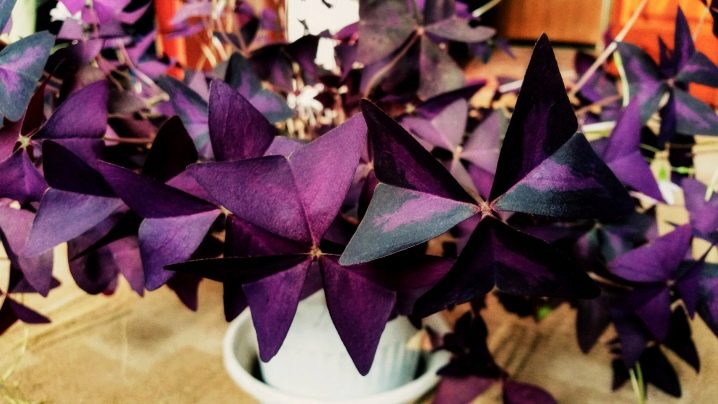
Description
Kislitsa is a genus of perennial grasses of the Kislichnye family. The second official name is oxalis. Translated into Russian, Oxalis means sour. The plant is a mesophyte, which means: oxalis in natural conditions lives in conditions with sufficient soil moisture, but not with excess. In addition, oxalis is very shade-tolerant, it can be grown even in a darkened room.
Plants have been known for a long time. One of the first mentions of acid is in the work of the Spanish missionary Bernardino de Sahagun "General history of the affairs of new Spain", which was written in 1547. The writer described sour sorrel as "local sorrel, sour, usually eaten boiled or raw." Indoor oxalis species are also grown in gardens.

The appearance of this beautiful flower is quite suitable for creating decorative compositions.
Across the world, the number of species of oxalis exceeds 800. The largest number of varieties prevails in Mexico, South America and South Africa. In the Russian Federation, you can find only 6 types of oxalis. In Russia it is often called the "butterfly flower" because of its appearance similar to its wings. In addition to this name, you can hear a variety of names: family happiness, hare cabbage, good morning, happy clover. This is due to the great popularity of species that are very different from each other.
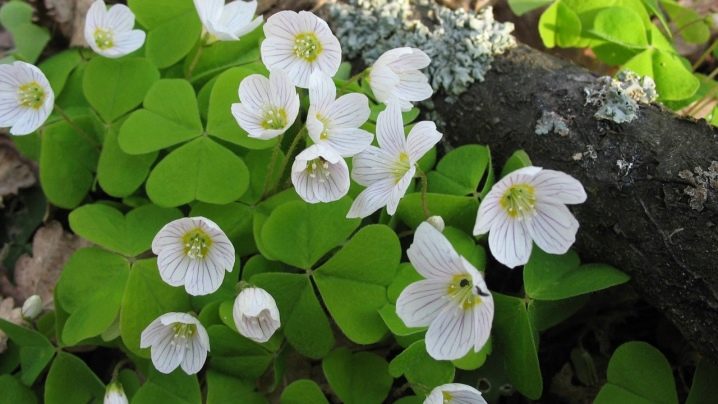
The color scheme of flowers is pink, white and purple. Flowers are collected in an umbrella, forming a dense inflorescence. The intensity of flowering and growth of acid is not very high. With due observance of the rules for leaving a small process of oxalis, it can grow to an average size in a year. The maximum plant size is 20–30 cm, but some species, for example, oxalis vulgaris, do not exceed 10 cm and are rhizomatous.
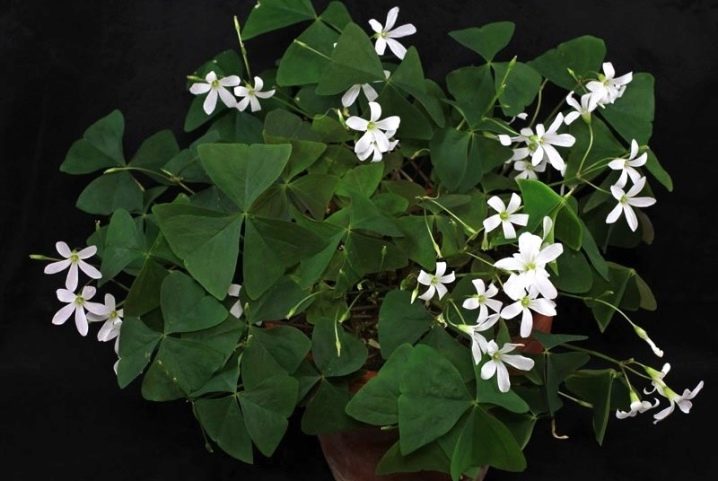
Care rules
At home, it is not difficult to monitor the well-being of sour acid, you just need to follow some rules.
- Although the plant is shade-tolerant, it needs light. However, direct sunlight should be avoided. The optimal location for oxalis will be on the east or west window. If, after rearranging to a new place, the tips of the leaves begin to acquire a green tint, you should change the habitat: this is a signal of a lack of light.

- Watering acid is no different from watering other flowers: you need to carefully observe the balance of soil moisture. Watering should be done frequently, but in small amounts. Once the topsoil is dry, add moisture. Three times a week is the average number of waterings.
Dry air on hot days can adversely affect the condition of the plant, therefore, during especially warm periods of time, it will not be superfluous to spray oxalis with water from a spray bottle.
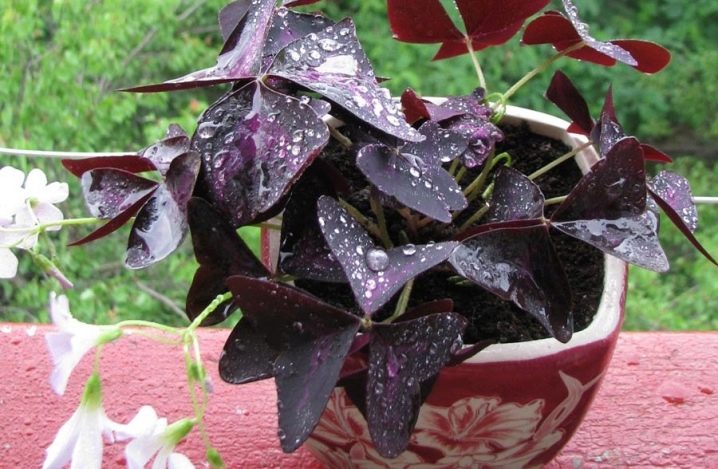
- Fertilizing with mineral fertilizers is desirable to do 2 times a month. You can buy any complex top dressing: oxalis does not require special elements.

- Temperature conditions are not critical, and even if the room is cool or hot, the plant can adapt. Ideally, in a room containing oxalis, it should be maintained at about 20-22 ° in summer and 15-17 ° in winter.
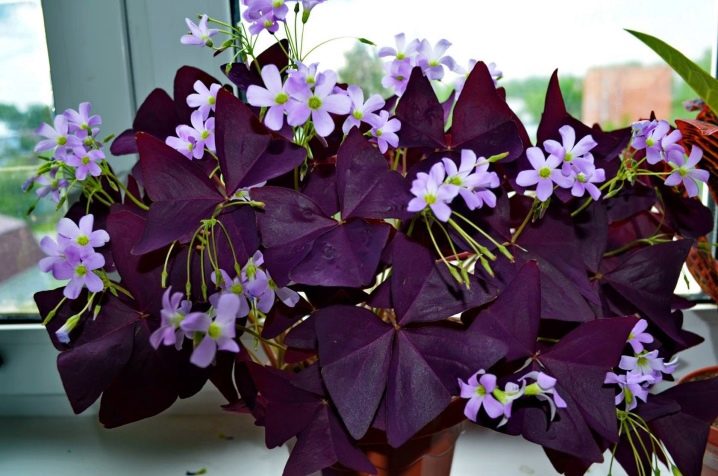
- The flowering process is fleeting. Therefore, after their wilting, you can carefully cut the dried flowers.
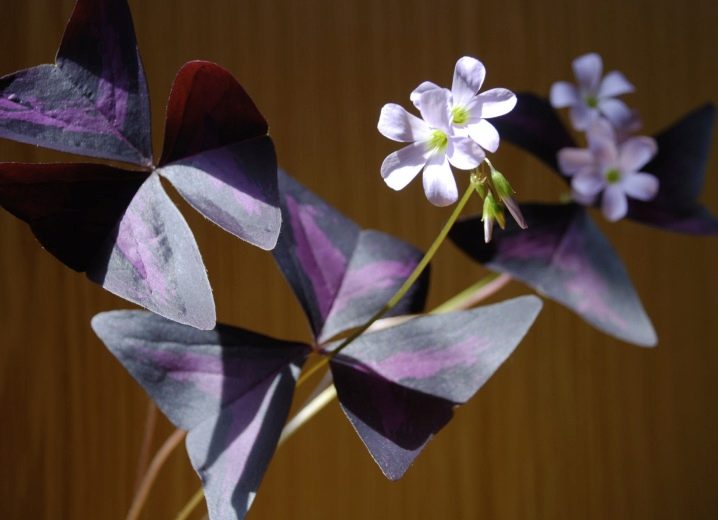
- You need to take care of oxalis in winter more carefully: during this period, most species rest. It is advisable to remove all shoots and put the pot in a cool place: this will enable oxalis to renew the body. Fertilizing the soil in the winter months is not worth it.

Reproduction methods
There are 4 ways to propagate oxalis in total. It propagates by seed in the wild on its own, and trying to grow seeds at home can fail. Other breeding options are more optimal.
- Propagation by daughter bulbs. The easiest way is to separate the bulbs from the root system of the flower and plant them in several separate containers, sprinkling them with a small amount of soil on top. Move seedlings to a cool place and create dark conditions. As the topsoil dries up, irrigate. As soon as the sprouts begin to hatch, you can rearrange the container with sprouts to a brighter room, and after a month a full-fledged bush will appear.
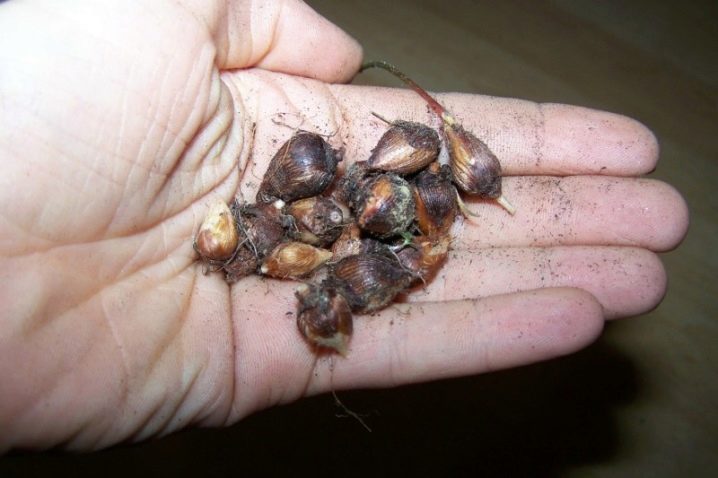
If the reproduction process was carried out in small containers, then after the bush has grown, it is advisable to transplant it to a wider place of residence: a medium-sized pot is suitable.
- Reproduction by dividing the bush. When the plant is sufficiently strong in the pot and has a strong root system, it should be propagated by dividing the roots. 4 hours before separation, the soil must be moistened: this is necessary to preserve the roots during transportation from the pot. When the bush was pulled out of the container, rinse its roots with potassium permanganate and clear them of soil. Next, you need to divide the bush into several parts and process the places with cuts with charcoal.

Medium illumination should be maintained constantly during the maturation of a new bush. When 15 days have passed, you can start feeding 2 times a month. A few months later, the grower will have an independent bush, which can later be propagated in the same way.
- Reproduction by a sheet. You need to choose the flower on which there are more than 3 sheets, and the length of which exceeds 10 cm. Carefully cut off the leaf and place it in a container with water. After some time, the formation of roots occurs on the leaf. When they are of an acceptable size, the sheet must be transferred to the finished soil. With proper care and frequent watering, the first leaves will soon begin to appear.
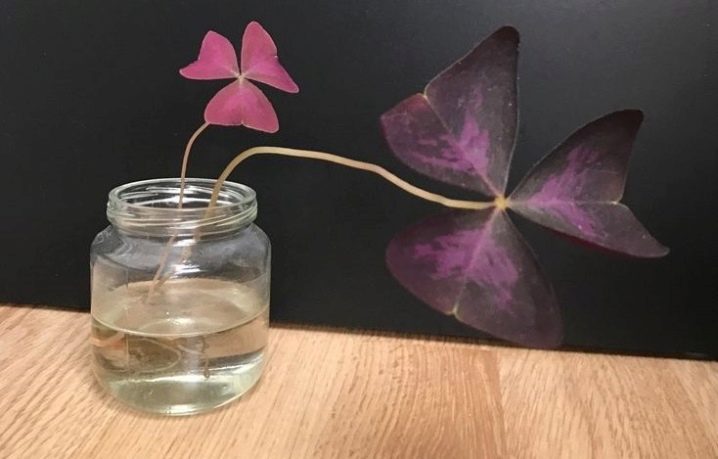
How to transplant acid sour?
Sour acid transplant is an integral process of caring for this indoor flower. Usually it is transplanted into a new pot every year, since the tubers during this period of time occupy all the soil allotted for them. If breeding is planned, it is necessary to pick up a new pot of a larger size than the previous one. If the transplantation process is associated with prevention, you can divide the bush and remove some unnecessary roots.

When the plant is fully ripe and has grown enough, you need to replant it. For a new pot, it is better to immediately prepare drainage, which will take up one third of the capacity: this will protect against overflows. The best time to change the habitat of the sorrel is spring. The transplant is performed step by step.
- Do drainage layer.
- Fill up the soil. You can buy standard soil for home flowers in the store or prepare it yourself: peat, sand, humus and leafy earth are taken in a 1X1X1X1 ratio and mixed. Experienced growers say it is beneficial to add a small amount of coconut flakes to the soil to provide more comfortable conditions for the plant.
- Remove acid from an old pot, clean the roots and place in a new "home".
- The first few days, carefully monitor the condition of the flower. Watering can be increased the first time after transplanting, but always check for excess water in the pan.

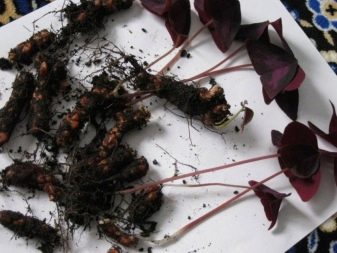
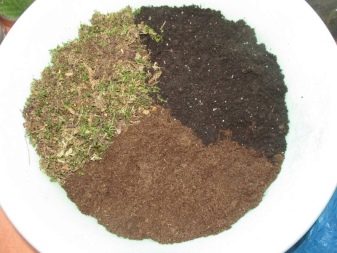

Diseases and pests
Oxalis, subject to all conditions of care, almost never gets sick and is not attacked by harmful insects. Most problems can be caused by:
- lack / excess of watering the plant;
- lack / excess of lighting;
- lack of dressing;
- too small pot.

Certain actions will often help to solve the problem.
- Find the optimal plant location, where direct sunlight will not hit the leaves, however, it will not be completely dark.
- Monitor the frequency and abundance of watering. And also check the soil and drain the water from the sump.
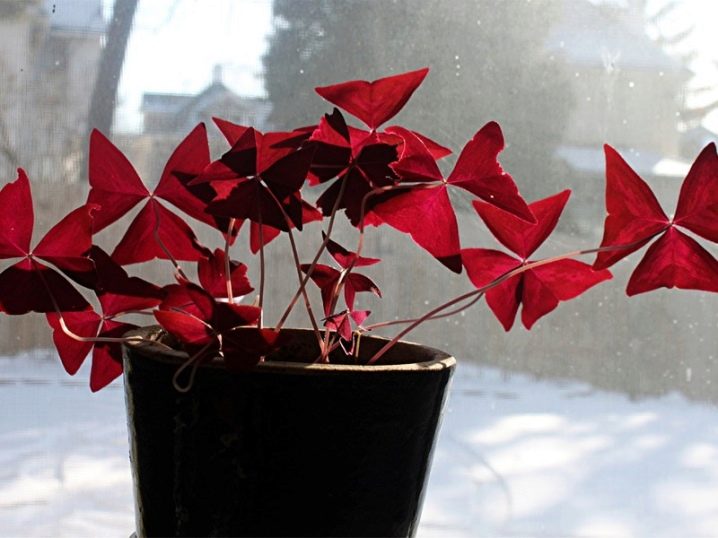
One of the most common problems is the following: the root system rots, and a mushroom mosquito settles in the roots. In this situation, it becomes more difficult to save a home resident. However, it is possible to return an indoor flower to a healthy existence.
- Remove the plant from the pot. Thoroughly and gently shake off the stuck earth from the roots.
- Cut off those processeson which rot has spread.
- Into the dried soil plant the sour cherry again.
- Spend a few days with moderate (less than usual) watering in order for the flower to adapt to new living conditions without a cut off part.
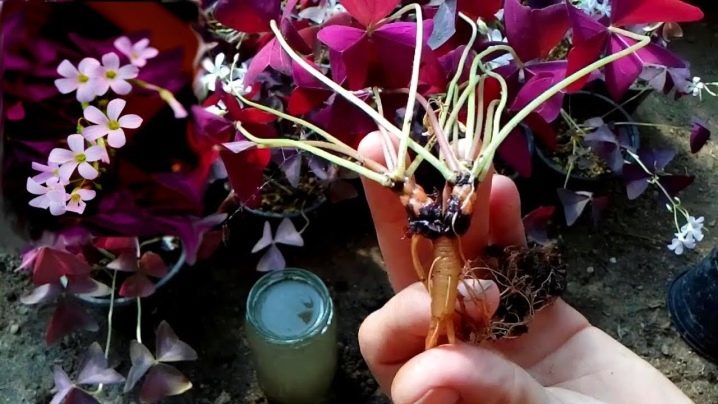
The number of pests that are eager to attack a home resident is large: mealybug, scale insect, whitefly. If you find any, do not hesitate and take measures to destroy enemies on the plant. The mealybug looks like a white bump on the leaves or shoots of oxalis. Gradually, as the worm multiplies, a white bloom forms on the leaves.



In Europe, there are 330 species of these hemiptera insects. Many indoor plants are susceptible to their attacks.
For treatment, it is necessary to wipe all affected areas on oxalis with a cotton pad dipped in soapy water. It will be useful to wipe all the leaves with an alcohol solution or calendula infusion. The procedure can be carried out once every few days. If the situation has not been triggered, no further action is required.
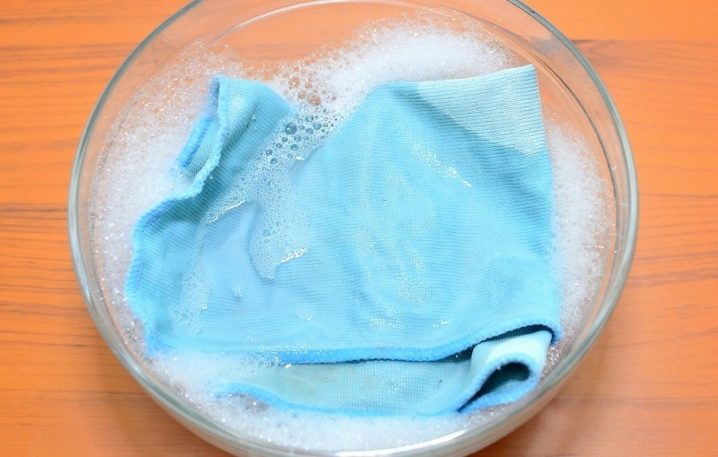
If the worm has already attacked a large area of the flower, it is worth resorting to chemicals. At intervals of 10 days, spray the affected areas with a solution that can be purchased at the store. Fitoferm, Tanrek and Biotlin have proven themselves best. These complex sprays will cause even a large colony of mealybugs to retreat.


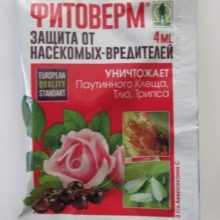
Shields resistant to external influences, therefore getting rid of them is associated with some difficulties. The scute, or small carapace, protects the insects from the environment. Insects are tightly attached to the surface of the oxalis, which makes it difficult to remove the individual. It is easy to notice scale insects: tubercles of different shades (depending on the type of parasite) will be on the leaves and shoots. However, in the early stages, the pest can only be detected by sticky leaves: insects leave behind a sticky liquid.

If the situation is running, you need to remove the adult scale insects. Chemicals will not affect them: the shells will protect the shield from any liquid. To remove insects from a leaf, you can soak a cotton swab or disc in soapy water and treat all the leaves on both sides, as well as the adjacent stems. Treat the plant, pot and nearby objects (as well as the wall and windowsill that are in the immediate vicinity of the pot) with chemicals. For this purpose, Actellik is suitable, but you need to remember: a pungent smell will accompany the process of treatment with this drug, so it is advisable to place the pot in an isolated place.

Isolation will also protect healthy plants from possible contamination.
Some of the most unpleasant pests are small butterflies that greedily swoop down on the plant. It appears on acid soil in cases when the soil becomes waterlogged at elevated air temperatures. In this case, you can see midges circling around the sour. The length of the pest does not exceed 3 mm, and the body is covered with powdery pollen. For an effective fight, rinse the acid under running water, which should be cool. Next, you can start treating the plant with insecticidal agents designed to combat whiteflies. It is best to purchase the drugs in a specialized store.
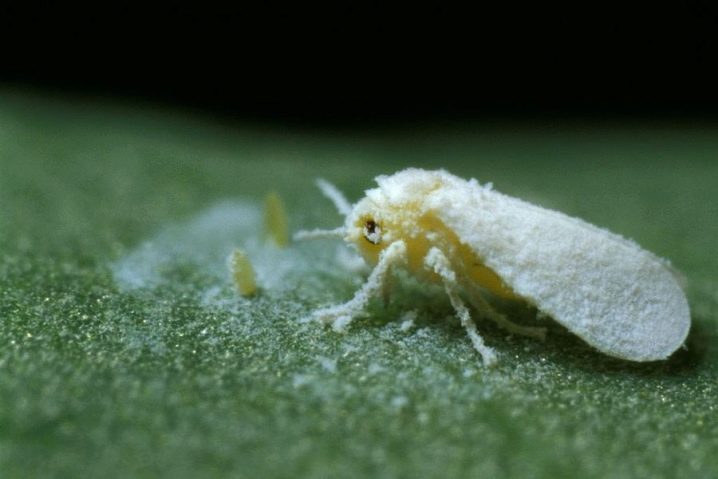
For the features of caring for sour, see the next video.

































































































The comment was sent successfully.